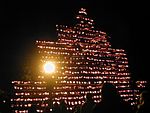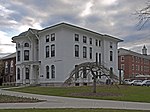Colony's Block
Buildings and structures in Keene, New HampshireCommercial buildings completed in 1870Commercial buildings on the National Register of Historic Places in New HampshireNational Register of Historic Places in Cheshire County, New HampshireSecond Empire architecture in New Hampshire

Colony's Block is a historic commercial building at 4-7 Central Square in the heart of Keene, New Hampshire. The five-story brick building was built in 1870 to a design by Worcester, Massachusetts, architects E. Boyden & Son, and is the city's most prominent example of Second Empire architecture. In addition to being a long-standing commercial center, the building housed the city library from 1870 to 1877. The building was listed on the National Register of Historic Places in 1983.
Excerpt from the Wikipedia article Colony's Block (License: CC BY-SA 3.0, Authors, Images).Colony's Block
Roxbury Street, Keene
Geographical coordinates (GPS) Address Nearby Places Show on map
Geographical coordinates (GPS)
| Latitude | Longitude |
|---|---|
| N 42.933888888889 ° | E -72.2775 ° |
Address
5 Central Square
Roxbury Street
03431 Keene
New Hampshire, United States
Open on Google Maps









